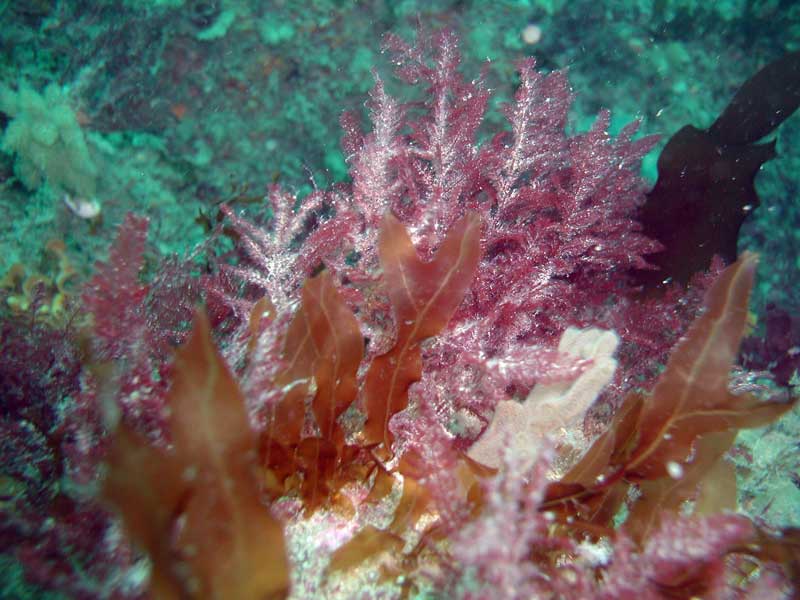Netted wing weed (Dictyopteris polypodioides)
Distribution data supplied by the Ocean Biodiversity Information System (OBIS). To interrogate UK data visit the NBN Atlas.Map Help
| Researched by | Marie Skewes | Refereed by | Admin |
| Authority | (A.P.De Candolle) J.V.Lamouroux, 1809 | ||
| Other common names | - | Synonyms | Dictyopteris membranacea |
Summary
Description
Up to 30 cm in length, Dictyopteris membranacea superficially resembles the Fucus species but is much more delicate. The frond is thinner (up to 15 cm wide), membranous and dotted with numerous clusters of tiny hairs. It is yellowish in colour when juvenile, growing darker brown with age. Newly collected specimens have an unpleasant odour.
Recorded distribution in Britain and Ireland
A southern species present in large amounts only in the extreme south-west of Britain with a few records from west Scotland.Global distribution
Present from the Netherlands to the Mediterranean and Western South Africa, in parts of the Caribbean, and Vietnam.Habitat
Dictyopteris membranacea is essentially a sublittoral species although it is sometimes found on the lower shore.Depth range
-Identifying features
- Prominent midrib.
- Frond flattened and branching dichotomously.
- Holdfast disc-like and fibrous.
- Tips of branches rounded and slightly split or notched.
Additional information
Can be distinguished from Dictyota dichotoma by its larger size and the presence of a midrib.
Listed by
- none -
Bibliography
Campbell, A.C., 1982. The Hamlyn guide to the flora and fauna of the Mediterranean Sea. London: Hamlyn.
Fish, J.D. & Fish, S., 1996. A student's guide to the seashore. Cambridge: Cambridge University Press.
Guiry, M.D. & Nic Dhonncha, E., 2002. AlgaeBase. World Wide Web electronic publication http://www.algaebase.org,
Hardy, F.G. & Guiry, M.D., 2003. A check-list and atlas of the seaweeds of Britain and Ireland. London: British Phycological Society
Hayward, P., Nelson-Smith, T. & Shields, C. 1996. Collins pocket guide. Sea shore of Britain and northern Europe. London: HarperCollins.
Hiscock, K., Southward, A., Tittley, I., Jory, A. & Hawkins, S., 2001. The impact of climate change on subtidal and intertidal benthic species in Scotland. Scottish National Heritage Research, Survey and Monitoring Report , no. 182., Edinburgh: Scottish National Heritage
Hiscock, S., 1979. A field key to the British brown seaweeds (Phaeophyta). Field Studies, 5, 1- 44.
Howson, C.M. & Picton, B.E., 1997. The species directory of the marine fauna and flora of the British Isles and surrounding seas. Belfast: Ulster Museum. [Ulster Museum publication, no. 276.]
Norton, T.A. (ed.), 1985. Provisional Atlas of the Marine Algae of Britain and Ireland. Huntingdon: Biological Records Centre, Institute of Terrestrial Ecology.
Datasets
Fenwick, 2018. Aphotomarine. Occurrence dataset http://www.aphotomarine.com/index.html Accessed via NBNAtlas.org on 2018-10-01
Manx Biological Recording Partnership, 2017. Isle of Man wildlife records from 01/01/2000 to 13/02/2017. Occurrence dataset: https://doi.org/10.15468/mopwow accessed via GBIF.org on 2018-10-01.
Manx Biological Recording Partnership, 2022. Isle of Man historical wildlife records 1990 to 1994. Occurrence dataset:https://doi.org/10.15468/aru16v accessed via GBIF.org on 2024-09-27.
NBN (National Biodiversity Network) Atlas. Available from: https://www.nbnatlas.org.
OBIS (Ocean Biodiversity Information System), 2025. Global map of species distribution using gridded data. Available from: Ocean Biogeographic Information System. www.iobis.org. Accessed: 2025-08-08
Citation
This review can be cited as:
Last Updated: 03/07/2007



